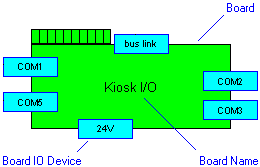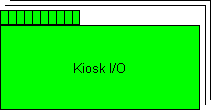Board (dictionary item)

For automation interface information about a Board, see
Board (automation interface).
Boards are the processing component within the system architecture. The detail of their composition is defined by a linked Board Type. A Board Type can be linked to many Boards. A Board Type describes:
• The Processors on the Board, their types and properties and the memory address for any on-board Memory.
• The Memory devices on the Board, their types and properties and their memory address.
• Any IO Devices on the Board, their types and properties and their memory address.
To change the characteristics of a Board you must change the linked Board Type.
You can create a Board through the context menu of a Package: right-click the Package, and select > > > .
In addition, you can also create a Board by copying an existing Board. Modeler copies the Board's links. For more information, see
Copying items.
When used on a System Architecture Diagram, a Board's notation is as follows:

If a Board has two or more instances, the following notation is used.

To specify that a Board runs the software of a Package, link the Board to the Package: From the Board's Property Pages, click the Items tab, select Packages in the Show Associated list, click the Link button, and then select the Package.
To see how a Board is defined using Board Type, Processor, Processor Type, Memory, Memory Type, Board IO Device and Board IO Device Type items, see  .
.
 .
.If you select the Proprietary\Boards folder in the Dictionary pane, the Contents pane displays the following information about each Attribute in the model: Base Address. |
The following sections provide information about how a Board is used in the model. For more information about a property, item, model part or diagram, click it.
Properties
In addition to the
standard properties a Board has these properties:
The Board Type list on the Options tab of a Board's Property Pages allows you to link the Board with a Board Type. |
Owned by
Owns
 Dependency - The Dependency is owned jointly by the Board and the other associated item. The access permissions you have to a Dependency are determined by the access permissions of the dependent item.
Dependency - The Dependency is owned jointly by the Board and the other associated item. The access permissions you have to a Dependency are determined by the access permissions of the dependent item. Point-to-point Connection - The Point-to-point Connection is owned jointly by the Board and the associated item. The access permissions you have to a Point to Point Connection are determined by the access permissions you have to the source item. Note that the Board does not own the Point-to-point Connections that are linked to the Board's Board IO Device.
Point-to-point Connection - The Point-to-point Connection is owned jointly by the Board and the associated item. The access permissions you have to a Point to Point Connection are determined by the access permissions you have to the source item. Note that the Board does not own the Point-to-point Connections that are linked to the Board's Board IO Device.Defined in these parts of the model
Shown on these diagrams
Can be linked to these dictionary items
 Board Type - The linked Board Type specifies the Board IO Device, Processor and Memory requirements for the board.
Board Type - The linked Board Type specifies the Board IO Device, Processor and Memory requirements for the board. Package - The Package's software resides on the Board. Note that in the opposite direction this link means that the Package owns the Board. For more information, see
Linking a package with a board.
Package - The Package's software resides on the Board. Note that in the opposite direction this link means that the Package owns the Board. For more information, see
Linking a package with a board. on the Board's icon indicates that the item is a stub. For more information, see
on the Board's icon indicates that the item is a stub. For more information, see
 Model
Model Comment
Comment Constraint
Constraint Drop
Drop System Architecture Model
System Architecture Model System Architecture Diagram
System Architecture Diagram Variant Diagram
Variant Diagram Stereotype
Stereotype Subsystem
Subsystem Task
Task